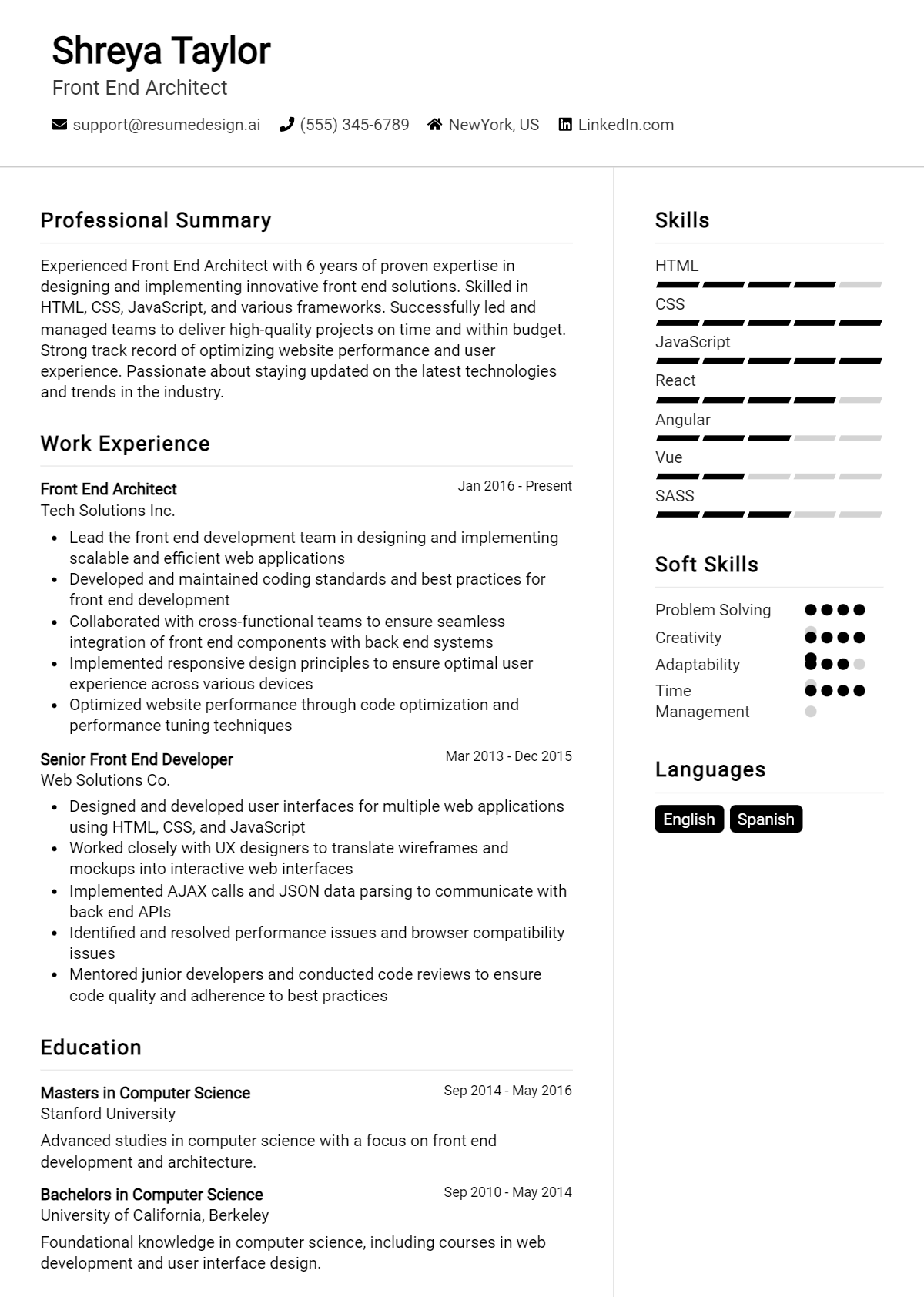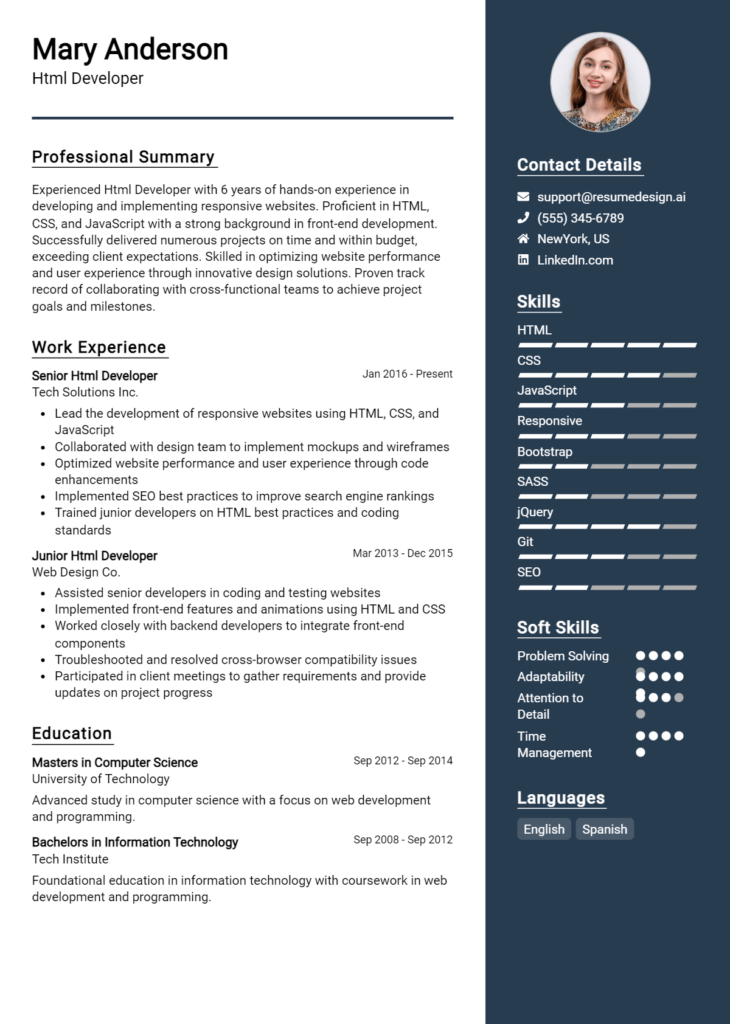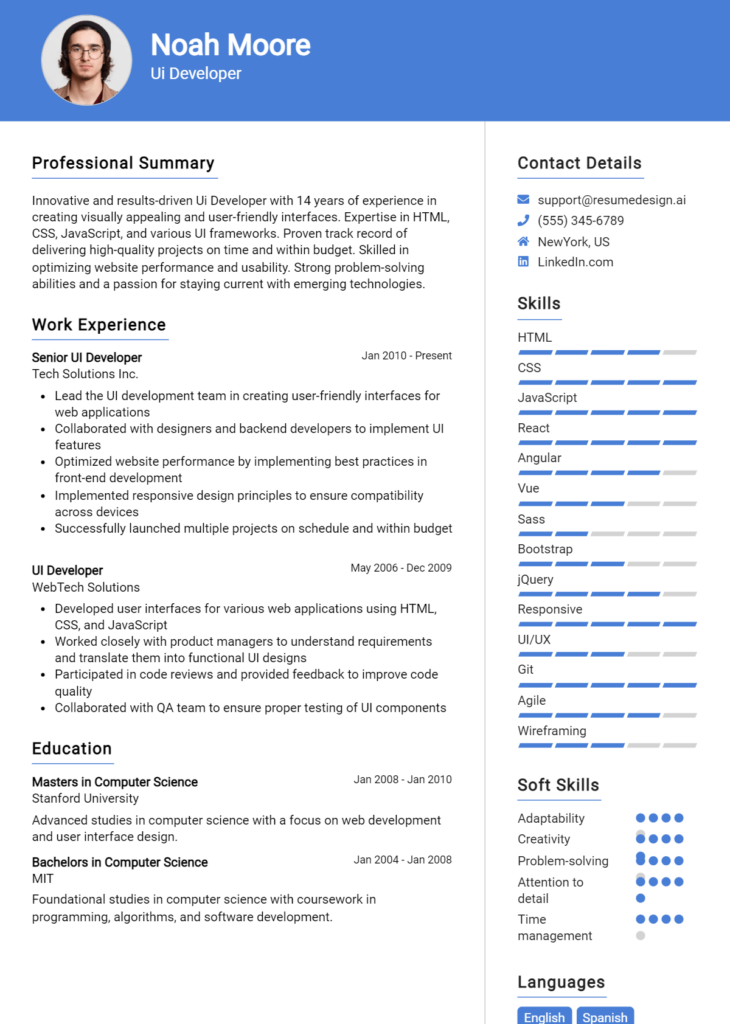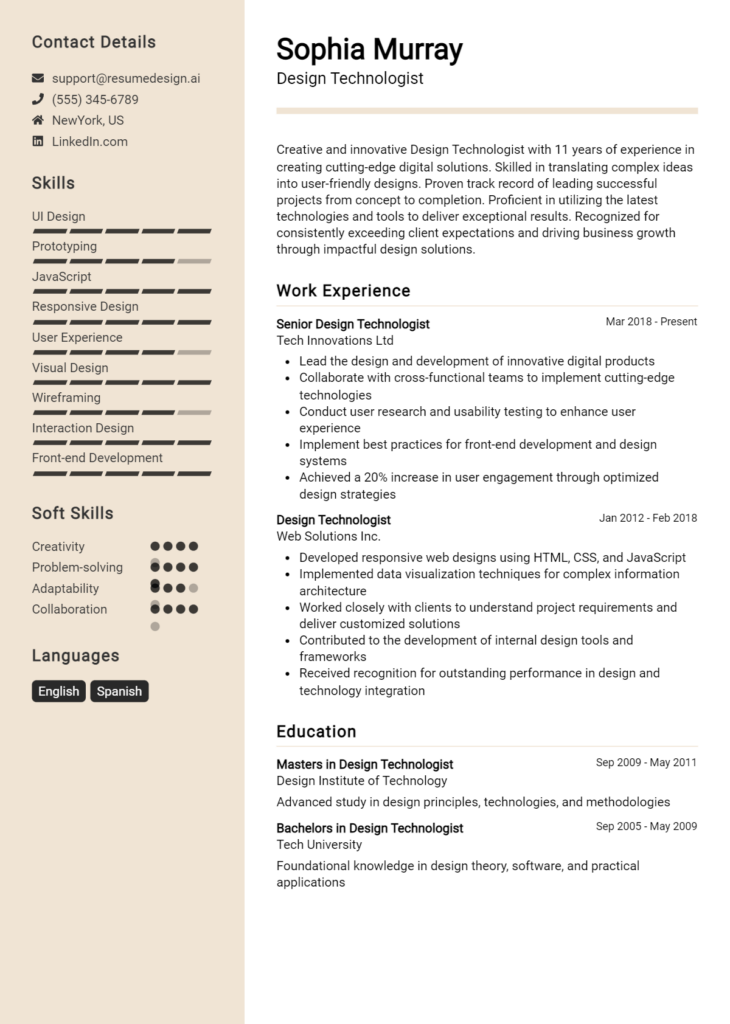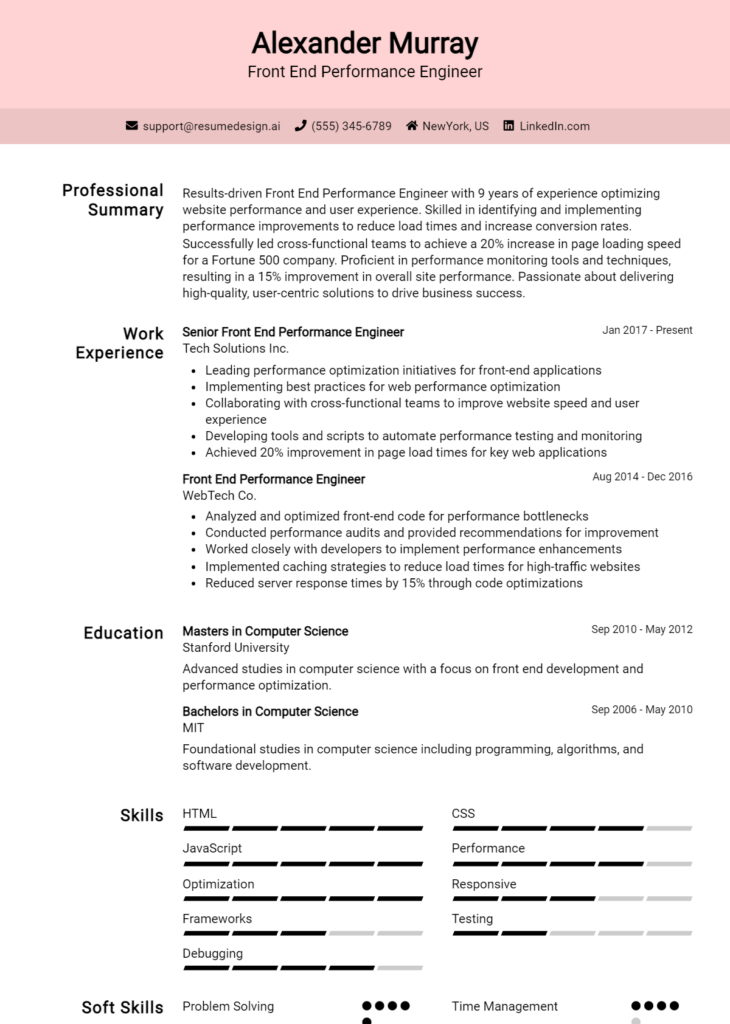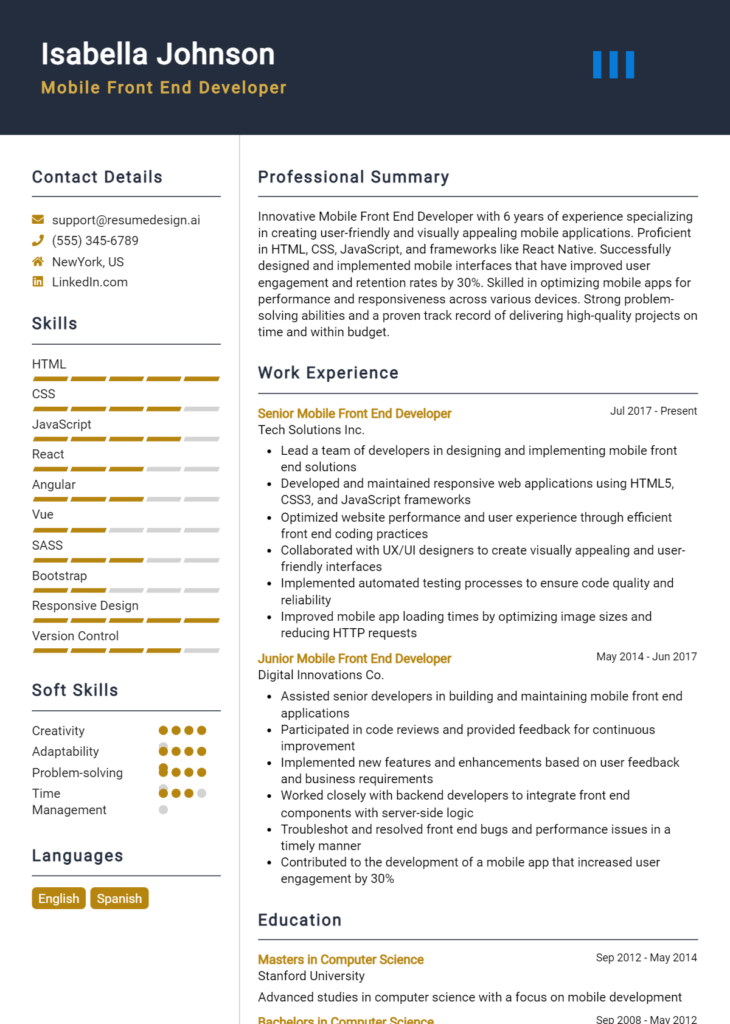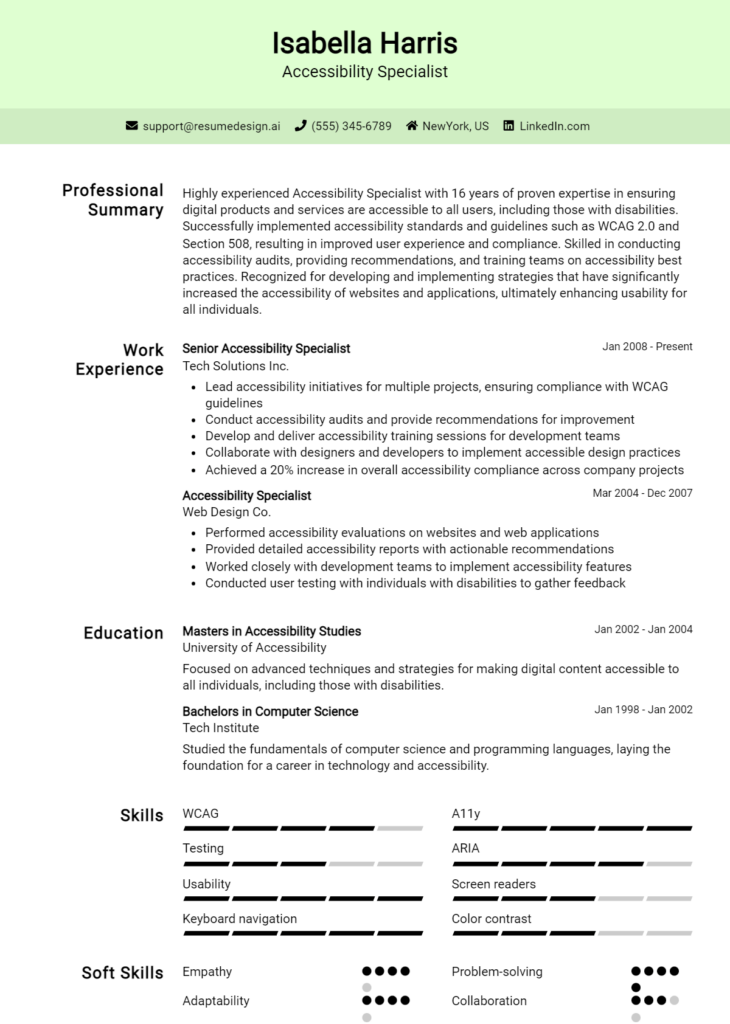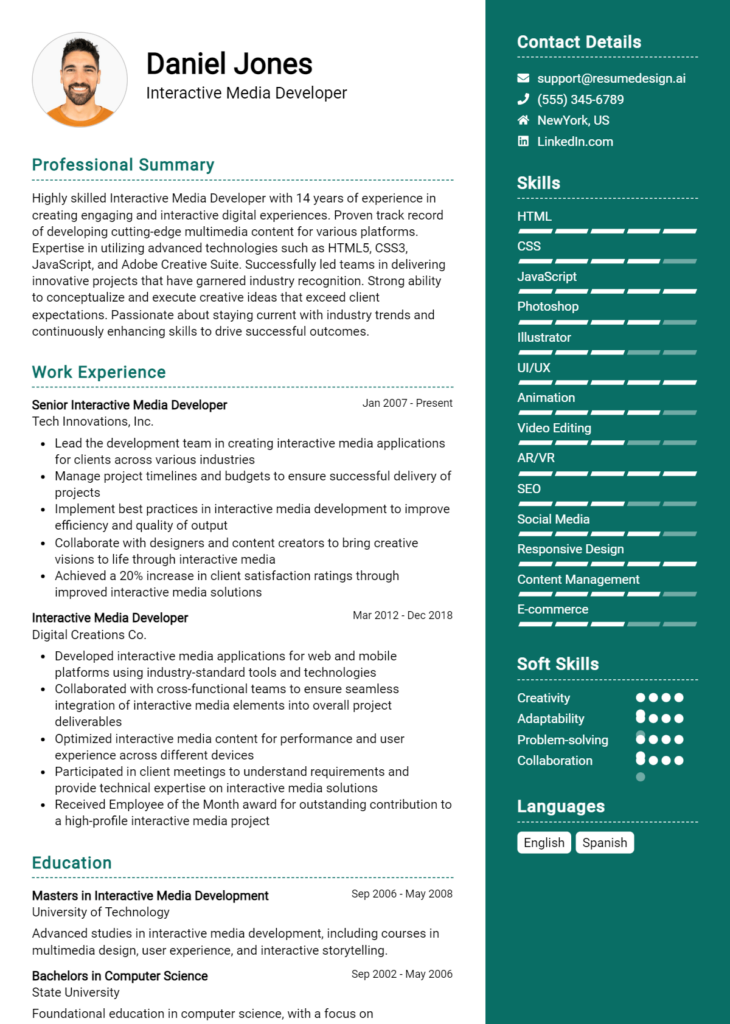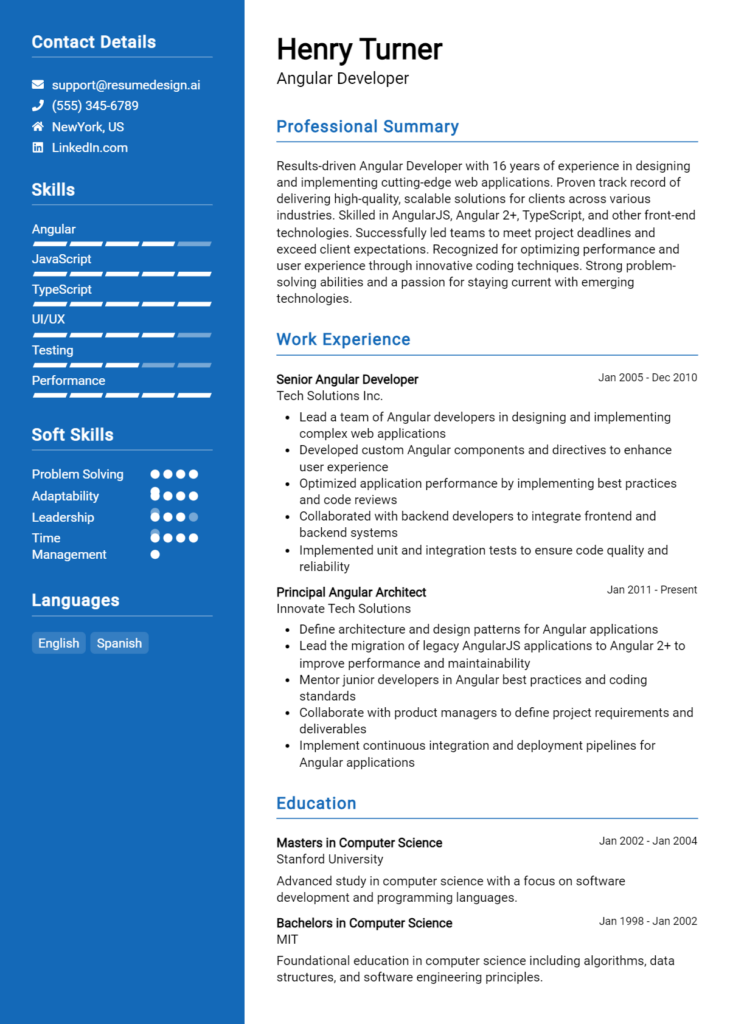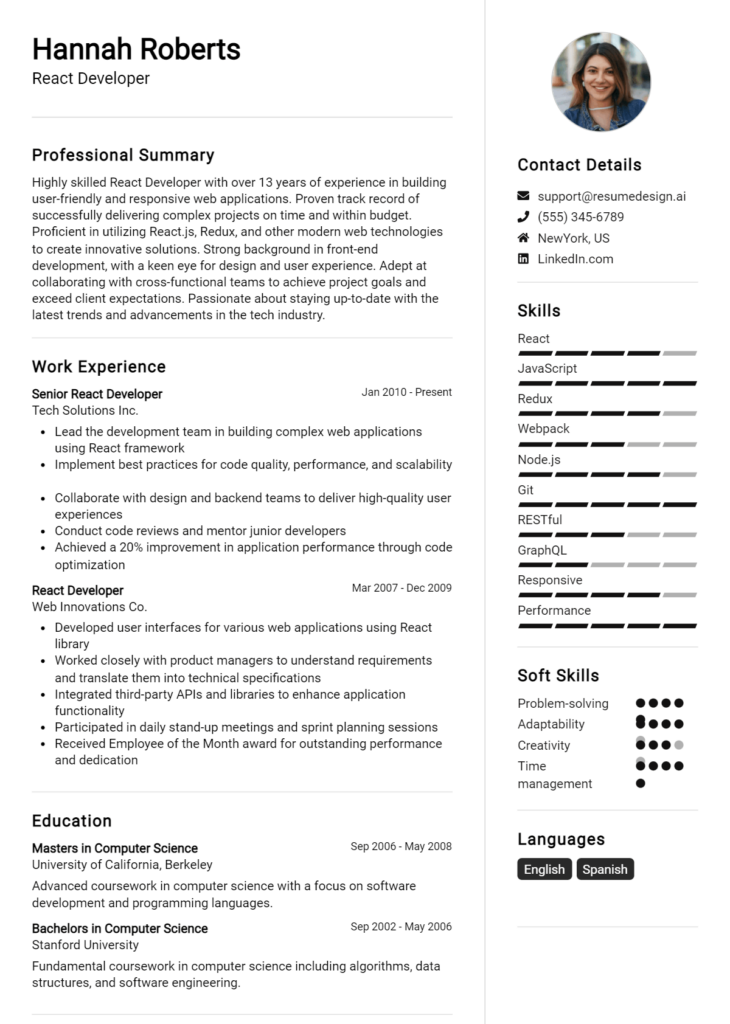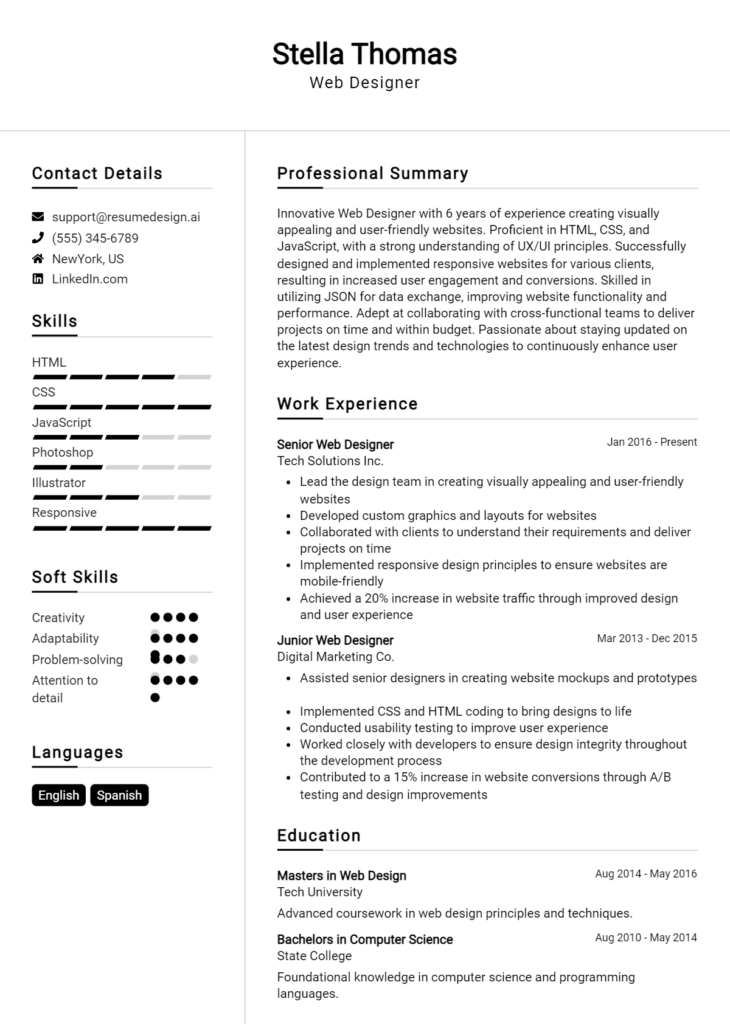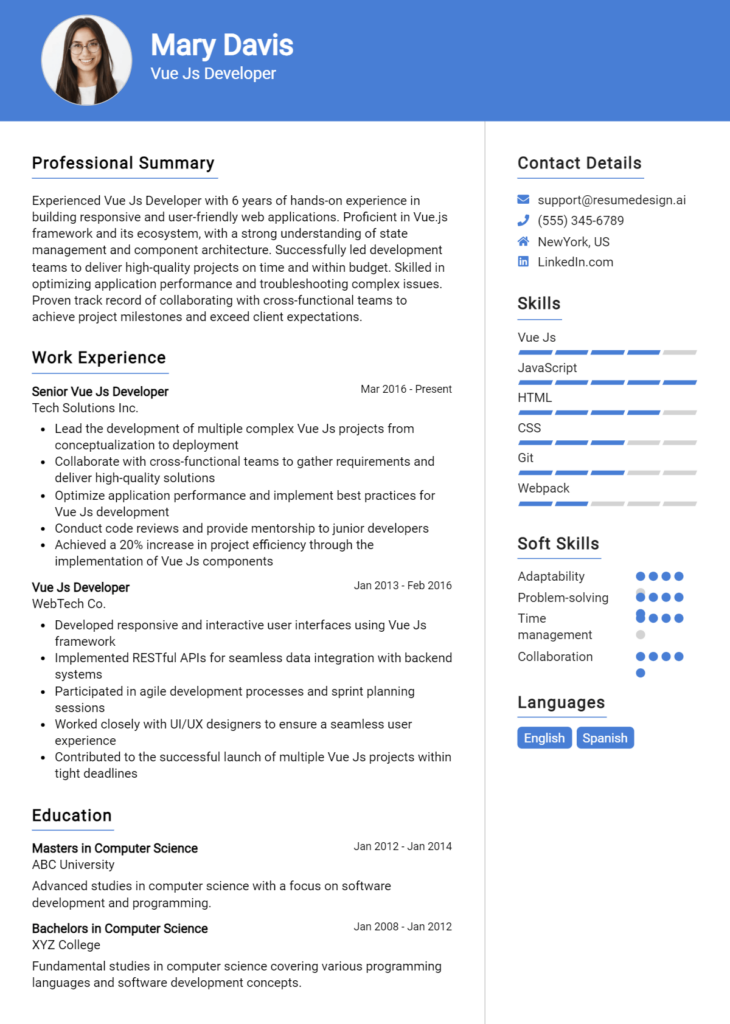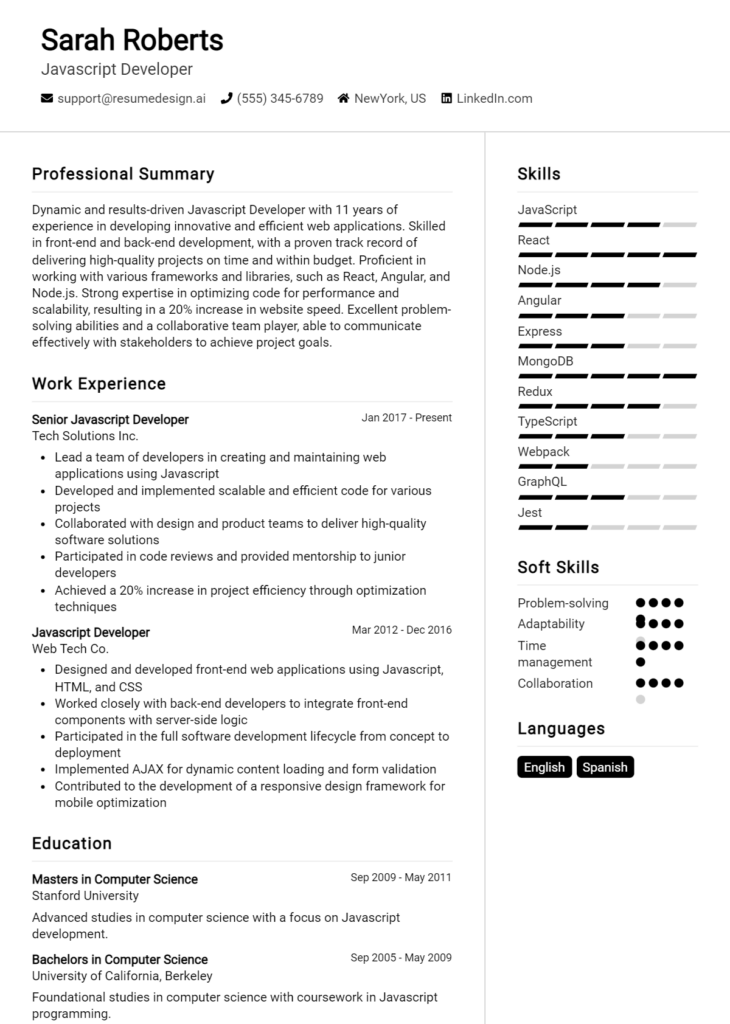Front-End Architect Core Responsibilities
A Front-End Architect plays a pivotal role in bridging design and development by ensuring seamless collaboration between UI/UX teams and back-end developers. Key responsibilities include designing scalable front-end architectures, optimizing performance, and establishing coding standards. Essential skills encompass strong technical expertise in frameworks, problem-solving abilities, and operational efficiency. These competencies contribute significantly to organizational goals, enhancing user experience and software quality. A well-structured resume is crucial to effectively highlight these qualifications and experiences.
Common Responsibilities Listed on Front-End Architect Resume
- Design and implement scalable front-end architectures.
- Collaborate with UX/UI designers to create user-friendly interfaces.
- Optimize application performance for speed and efficiency.
- Establish and enforce coding standards and best practices.
- Conduct code reviews and provide mentorship to development teams.
- Integrate APIs and ensure seamless back-end communication.
- Stay updated on industry trends and emerging technologies.
- Lead cross-functional teams in software development projects.
- Develop documentation for front-end architecture and processes.
- Identify and troubleshoot front-end issues proactively.
- Facilitate communication between technical and non-technical stakeholders.
- Contribute to the overall strategy for product development.
High-Level Resume Tips for Front-End Architect Professionals
In the competitive field of Front-End Architecture, a well-crafted resume is not just a formality; it is a critical tool that can open doors to new opportunities. As the first impression a potential employer will have of you, your resume must effectively showcase your technical skills, relevant experience, and notable achievements. It should serve as a compelling narrative that reflects your expertise in building sophisticated user interfaces and your ability to lead projects from conception to implementation. This guide will provide practical and actionable resume tips specifically tailored for Front-End Architect professionals, ensuring that your application stands out in a crowded job market.
Top Resume Tips for Front-End Architect Professionals
- Tailor your resume to match the specific job description, emphasizing the skills and experiences that align with the position.
- Showcase relevant experience, including previous roles that highlight your proficiency in front-end technologies such as HTML, CSS, JavaScript, and frameworks like React or Angular.
- Quantify your achievements by including metrics, such as the percentage improvement in load times or user engagement rates from your projects.
- Highlight industry-specific skills, such as responsive design, accessibility standards, and performance optimization techniques.
- Include a summary statement that encapsulates your professional identity, showcasing your years of experience and key areas of expertise.
- Utilize keywords from the job posting to enhance your resume's visibility to applicant tracking systems (ATS).
- Focus on your leadership abilities, including project management skills and experience leading cross-functional teams.
- Incorporate links to your portfolio or GitHub repository to provide tangible evidence of your work and coding capabilities.
- Keep the design clean and professional, ensuring that the layout is easy to read and visually appealing.
- Regularly update your resume with new skills or projects to reflect your growth and adaptability in a fast-paced industry.
By implementing these tips, you can significantly increase your chances of landing a job in the Front-End Architect field. A well-structured and targeted resume not only highlights your qualifications but also demonstrates your commitment to excellence, making you a more attractive candidate to potential employers.
Why Resume Headlines & Titles are Important for Front-End Architect
In the competitive landscape of tech recruitment, a Front-End Architect’s resume must stand out from the crowd. One of the most effective ways to achieve this is through impactful resume headlines and titles. A strong headline not only captures the attention of hiring managers but also succinctly summarizes the candidate’s key qualifications and expertise in a single, powerful phrase. It should be concise, relevant, and directly aligned with the specific job being applied for, serving as a quick reference that highlights the candidate's unique selling points.
Best Practices for Crafting Resume Headlines for Front-End Architect
- Keep it concise: Aim for a headline that is brief yet informative, ideally within 8-12 words.
- Be role-specific: Tailor the headline to reflect the specific position of Front-End Architect.
- Highlight key skills: Incorporate essential skills or technologies that are relevant to the job.
- Showcase experience level: Mention your years of experience or seniority level if applicable.
- Include measurable achievements: Use quantifiable outcomes where possible to demonstrate impact.
- Use action-oriented language: Start with strong verbs that convey confidence and capability.
- Avoid jargon: Use clear language that is easily understood rather than overly technical terms.
- Make it unique: Differentiate yourself by including specific aspects of your professional identity.
Example Resume Headlines for Front-End Architect
Strong Resume Headlines
Innovative Front-End Architect with 10+ Years in Responsive Design
Senior Front-End Architect Specializing in JavaScript Frameworks and UI/UX Enhancements
Expert Front-End Architect: Driving User-Centric Solutions with Scalable Code
Weak Resume Headlines
Experienced Developer
Front-End Specialist Looking for Opportunities
The strong headlines are effective because they clearly communicate the candidate's level of experience, specific skills, and unique contributions to previous roles. They convey confidence and relevance, which can compel hiring managers to read further. In contrast, the weak headlines fail to impress because they lack specificity and do not provide any insight into the candidate's qualifications or strengths, making them easily forgettable in a sea of applications.
Writing an Exceptional Front-End Architect Resume Summary
A well-crafted resume summary is crucial for a Front-End Architect as it serves as the first impression for hiring managers. This section of the resume quickly captures attention by highlighting the candidate’s key skills, relevant experience, and significant accomplishments in a concise manner. A strong summary not only distinguishes a candidate in a competitive job market but also aligns their expertise with the specific requirements of the role they are applying for. Ultimately, an impactful summary can greatly enhance the likelihood of securing an interview.
Best Practices for Writing a Front-End Architect Resume Summary
- Quantify Achievements: Use numbers and metrics to demonstrate the impact of your work.
- Focus on Skills: Highlight specific technical and soft skills relevant to the role.
- Tailor the Summary: Customize your summary to match the job description and company culture.
- Be Concise: Keep the summary brief, ideally 2-4 sentences, to maintain clarity and focus.
- Use Action Verbs: Start with strong action verbs to create a dynamic tone.
- Showcase Relevant Experience: Include key projects or roles that relate directly to front-end architecture.
- Highlight Industry Knowledge: Mention familiarity with current technologies, frameworks, and best practices in front-end development.
- Convey Passion: Reflect enthusiasm for front-end development and a commitment to user experience.
Example Front-End Architect Resume Summaries
Strong Resume Summaries
Results-driven Front-End Architect with over 8 years of experience in designing scalable web applications. Spearheaded a project that improved site performance by 30%, leading to a 20% increase in customer satisfaction.
Innovative Front-End Architect skilled in React and Angular, successfully led a team to launch a mobile-responsive platform that boosted user engagement by 50%. Adept at collaborating across teams to enhance UX/UI.
Detail-oriented Front-End Architect with extensive experience in HTML, CSS, and JavaScript. Developed a complex e-commerce site that achieved a 40% reduction in load time, significantly enhancing conversion rates.
Weak Resume Summaries
Experienced web developer looking for opportunities in front-end development. I have a variety of skills that could be useful in many projects.
A passionate software engineer with some experience in front-end technologies. I am eager to apply my skills in a new role.
The strong resume summaries are considered effective because they provide specific achievements, quantify results, and directly relate to the skills and experiences desired by potential employers. In contrast, the weak summaries are vague, lack measurable outcomes, and fail to convey the candidate's unique qualifications, making them less compelling to hiring managers.
Work Experience Section for Front-End Architect Resume
The work experience section of a Front-End Architect resume is crucial as it provides potential employers with insights into the candidate's technical skills, leadership capabilities, and ability to deliver high-quality products. It serves as a platform to showcase not only the projects undertaken but also the tangible results achieved. By quantifying achievements and aligning experiences with industry standards, candidates can demonstrate their effectiveness in driving innovation and enhancing user experience, making it an essential component of a compelling resume.
Best Practices for Front-End Architect Work Experience
- Focus on quantifiable achievements, such as performance improvements or user engagement metrics.
- Highlight leadership roles in project management and team collaboration.
- Detail specific technologies, frameworks, and methodologies used in your projects.
- Include metrics that demonstrate the impact of your architecture decisions on product quality.
- Showcase contributions to cross-functional teams and stakeholder communications.
- Tailor experiences to align with the specific requirements of the job you are applying for.
- Use action verbs to describe your contributions and responsibilities clearly.
- Keep descriptions concise while ensuring they convey the depth of your experience.
Example Work Experiences for Front-End Architect
Strong Experiences
- Led a team of 10 developers in the successful migration of a legacy system to a microservices architecture, resulting in a 40% increase in system performance and a 30% reduction in downtime.
- Architected a responsive web application that improved user engagement by 50%, utilizing React and Redux to streamline state management.
- Collaborated with UX designers and product managers to redesign an e-commerce platform, achieving a 25% increase in conversion rates within three months of launch.
- Implemented automated testing strategies that reduced bug reports by 60% and improved deployment speed by 35% across multiple projects.
Weak Experiences
- Worked on various web applications without specifying the technologies used.
- Involved in team meetings and discussions.
- Helped improve website performance.
- Contributed to several projects within the company.
The experiences listed as strong effectively convey clear, quantifiable outcomes and specific contributions, showcasing the candidate's technical expertise and leadership skills. In contrast, the weak experiences lack specificity and measurable results, making them less impactful and failing to illustrate the candidate's true capabilities as a Front-End Architect.
Education and Certifications Section for Front-End Architect Resume
The education and certifications section of a Front-End Architect resume is crucial as it showcases the candidate's academic background and commitment to continuous professional development. This section not only highlights relevant degrees and industry-recognized certifications but also emphasizes specialized training that aligns with the technical demands of the role. By providing information about relevant coursework and ongoing learning efforts, candidates can significantly enhance their credibility and demonstrate their preparedness for the responsibilities of a Front-End Architect.
Best Practices for Front-End Architect Education and Certifications
- Focus on relevant degrees in Computer Science, Information Technology, or related fields.
- Include industry-recognized certifications, such as Certified ScrumMaster (CSM) or AWS Certified Solutions Architect.
- Highlight specialized training in front-end technologies, such as React, Angular, or Vue.js.
- List relevant coursework that demonstrates practical skills and knowledge applicable to front-end architecture.
- Prioritize recent certifications to show ongoing commitment to learning.
- Consider including online courses or bootcamps that offer up-to-date training in emerging technologies.
- Use clear formatting to ensure easy readability and quick reference for hiring managers.
- Tailor the content to align with the specific requirements of the job description.
Example Education and Certifications for Front-End Architect
Strong Examples
- B.S. in Computer Science from Stanford University
- Certified Front-End Developer (CFED) from the International Association of Software Architects
- Advanced JavaScript and React.js Training from Coursera
- Certificate in User Experience Design from Nielsen Norman Group
Weak Examples
- B.A. in English Literature from University of Texas
- Certification in Microsoft Office Suite
- Old certification in Flash Development (2008)
- High School Diploma with no technical courses
The strong examples are considered effective because they directly relate to the skills and knowledge required for a Front-End Architect role, showcasing both relevant degrees and up-to-date certifications that demonstrate a commitment to the field. In contrast, the weak examples illustrate a lack of relevance and specificity to front-end architecture, with outdated certifications and unrelated degrees that do not align with the demands of the position.
Top Skills & Keywords for Front-End Architect Resume
As a Front-End Architect, the importance of showcasing the right skills in your resume cannot be overstated. This role requires a unique blend of technical expertise and interpersonal abilities to design and implement user-friendly interfaces that meet both business needs and user expectations. A well-crafted resume that highlights your skills can help you stand out in a competitive job market, demonstrating your capability to lead projects, collaborate with teams, and deliver exceptional digital experiences. Emphasizing both hard and soft skills can provide potential employers with a comprehensive view of your qualifications, making it easier for them to assess your fit for the role.
Top Hard & Soft Skills for Front-End Architect
Soft Skills
- Excellent communication skills
- Strong leadership abilities
- Problem-solving mindset
- Team collaboration and facilitation
- Adaptability to new technologies
- Time management and organization
- Attention to detail
- Critical thinking skills
- Creativity and innovation
- Conflict resolution
Hard Skills
- Proficiency in HTML, CSS, and JavaScript
- Experience with front-end frameworks (e.g., React, Angular, Vue.js)
- Knowledge of responsive design principles
- Familiarity with version control systems (e.g., Git)
- Understanding of web performance optimization
- Experience with UI/UX design principles
- Proficiency in testing frameworks and tools (e.g., Jest, Mocha)
- Familiarity with RESTful APIs and integration
- Knowledge of accessibility standards (WCAG)
- Experience in Agile methodologies and project management tools
For further insights into the essential skills and how to effectively present your work experience, exploring these resources can be invaluable in crafting an impactful resume.
Stand Out with a Winning Front-End Architect Cover Letter
Dear [Hiring Manager's Name],
I am excited to submit my application for the Front-End Architect position at [Company Name], as advertised on [where you found the job listing]. With over [X years] of experience in front-end development and architecture, I have honed my skills in creating scalable, user-centric applications that prioritize performance and maintainability. My expertise in modern frameworks such as React and Angular, combined with a strong foundation in web standards and best practices, positions me uniquely to contribute to your team and drive innovative solutions at [Company Name].
In my previous role at [Previous Company Name], I led a team of developers in overhauling the front-end architecture for a large-scale e-commerce platform. By implementing a component-based architecture and optimizing the application for mobile responsiveness, we achieved a 40% increase in page load speed and significantly improved the user experience. My passion for fostering collaboration among cross-functional teams allowed us to align our technical goals with business objectives, ensuring that our architectural decisions supported the overall vision for the product.
As a proactive problem solver, I thrive in dynamic environments where I can leverage my skills to tackle complex challenges. I am particularly drawn to [Company Name] because of its commitment to [specific value or project related to the company], and I am eager to contribute my expertise to help shape the future of your front-end architecture. I look forward to the opportunity to discuss how my background, skills, and enthusiasm for front-end development align with the goals of your team.
Thank you for considering my application. I am excited about the possibility of joining [Company Name] and contributing to your innovative projects. I look forward to the opportunity for an interview to discuss my candidacy further.
Sincerely,
[Your Name]
[Your LinkedIn Profile]
[Your Contact Information]
Common Mistakes to Avoid in a Front-End Architect Resume
When crafting a resume for a Front-End Architect position, it's essential to present your skills and experiences in a manner that resonates with hiring managers. However, many candidates make common mistakes that can hinder their chances of securing an interview. Avoiding these pitfalls can significantly enhance the effectiveness of your resume and showcase your qualifications more compellingly.
Lack of Tailoring: Failing to customize your resume for the specific job can make it seem generic. Highlight relevant skills and experiences that align with the job description.
Overloading with Technical Jargon: While technical expertise is crucial, using excessive jargon can alienate non-technical recruiters. Aim for a balance between showcasing your skills and ensuring clarity.
Ignoring Soft Skills: Front-End Architects need strong communication and teamwork abilities. Neglecting to mention these skills can give an incomplete picture of your capabilities.
Vague Job Descriptions: Simply listing duties without quantifying accomplishments can make your resume less impactful. Use specific metrics or outcomes to illustrate your contributions.
Neglecting Design Principles: A Front-End Architect should have a keen sense of design. Failing to highlight your understanding of design principles and user experience can be a missed opportunity.
Inconsistent Formatting: A poorly formatted resume can distract from your qualifications. Ensure consistency in font styles, sizes, and spacing for a professional appearance.
Omitting Relevant Projects: Not including significant projects or case studies can diminish your credibility. Showcase your past work to demonstrate your problem-solving abilities and design thinking.
Not Updating Skills: The front-end landscape evolves rapidly. Failing to keep your skills current or omitting recent technologies can make you seem out of touch with industry trends.
Conclusion
As we conclude our exploration of the Front-End Architect role, it’s essential to reflect on the key competencies and responsibilities that define this position. A successful Front-End Architect not only possesses a deep understanding of web technologies and frameworks but also demonstrates leadership in guiding development teams toward creating scalable and user-friendly applications. Emphasis on performance optimization, accessibility standards, and the ability to balance design with functionality are critical aspects of this role.
Moreover, collaboration with stakeholders, including UX/UI designers and back-end developers, is paramount to ensure cohesive and effective project execution. As the digital landscape continues to evolve, staying updated with emerging trends and tools is vital for any Front-End Architect aiming to excel in their career.
Now is the perfect time to assess your Front-End Architect resume and ensure it highlights your expertise and accomplishments effectively. To help you in this process, consider utilizing various resources available to enhance your job application. Explore resume templates to find a design that suits your professional style, or use our resume builder for a step-by-step guide to crafting your resume. Additionally, reviewing resume examples can provide inspiration and insights into how successful candidates present their skills. Don’t forget to complement your resume with a polished cover letter template to make a lasting impression on potential employers.
Take action today and ensure your resume stands out in the competitive job market for Front-End Architects!

